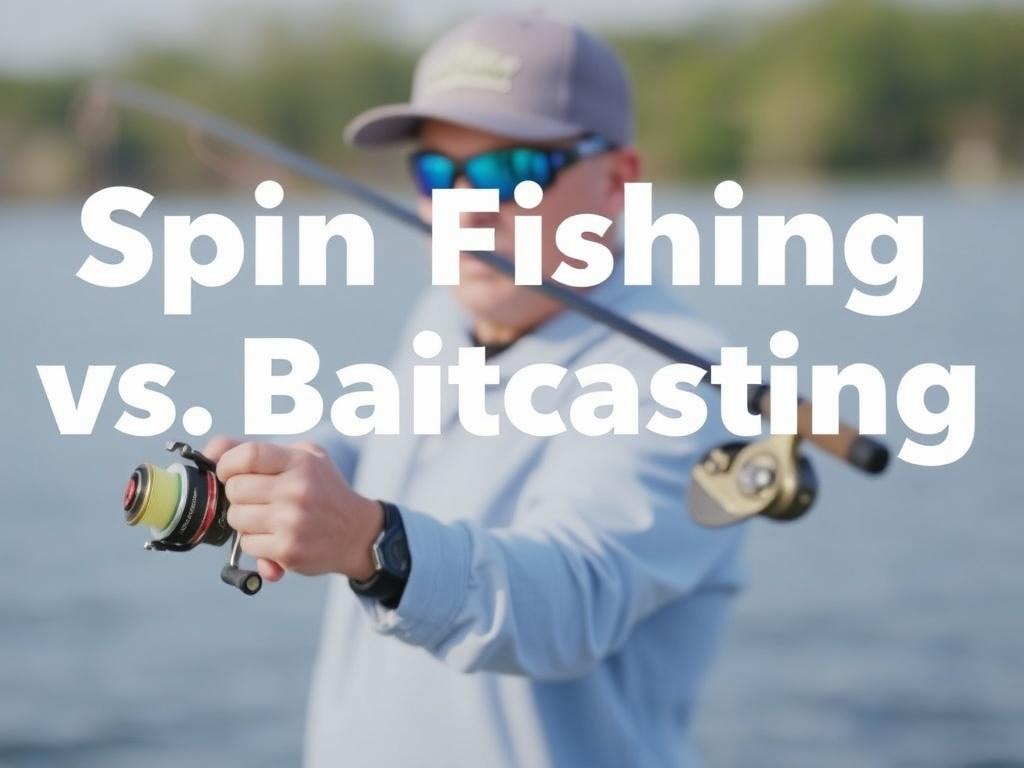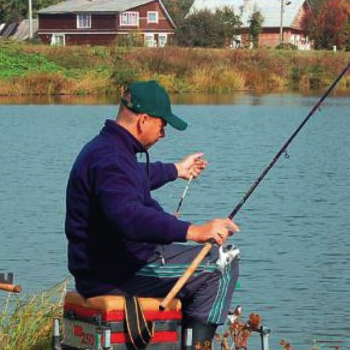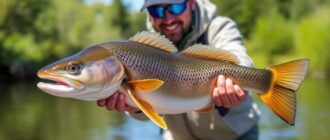- Understanding Spin Fishing: The Basics
- The Spin Fishing Setup
- Baitcasting Explained: What’s Different?
- The Baitcasting Setup
- Spin Fishing vs. Baitcasting: Pros and Cons
- Who Should Choose Spin Fishing?
- Is Baitcasting Better for More Experienced Anglers?
- Key Tips for Using a Baitcasting Reel
- Common Mistakes to Avoid
- Comparing Equipment Costs
- Environmental and Target Species Considerations
- Summary of Target Environments and Species
- Learning Curve and Skill Development
- Maintaining Your Gear
- Maintenance Checklist
- Conclusion
When it comes to fishing, the choice of equipment can make a huge difference in your overall experience and success on the water. Two of the most popular types of fishing reels that anglers often debate about are the spinning reel and the baitcasting reel. If you’re new to fishing, or even if you’ve been at it for a while but haven’t fully explored these options, you might find yourself wondering: spin fishing vs. baitcasting – which is right for you? Each technique has its own advantages and challenges, and understanding these differences will help you choose the gear that fits your style, skills, and the types of fish you want to catch.
Understanding Spin Fishing: The Basics
Spin fishing, or using a spinning reel, is the most common and beginner-friendly technique around. The spinning reel sits beneath the rod when you cast and has a spool that stays stationary while the line is released by the bail arm. This design helps prevent line tangles and backlash, making it great for those just starting out. One of the biggest advantages of spin fishing is its versatility. Whether you’re fishing from shore, pier, or boat, spinning reels can handle a wide range of lures and bait, from lightweight small jigs to medium-sized crankbaits.
One of the major benefits of spin fishing is ease of use. With a spinning reel, casting is straightforward and requires very little practice to get accustomed to. The line flows off the spool smoothly during the cast, which means you can achieve good casting distance even with lighter tackle. Spin reels are also generally less expensive than baitcasting reels, making them a budget-friendly option. Plus, they tend to require less maintenance and are forgiving if you make small mistakes with your casting technique.
The Spin Fishing Setup
A typical spin fishing outfit consists of a spinning rod paired with a spinning reel. These rods are generally lighter in action and come in various lengths, allowing anglers to adapt to different fishing environments. The reel’s drag system, located on the front or rear of the spool, helps control the tension when you hook a fish, preventing line breakage. Because of their design, spin reels work best with monofilament or braided lines and are ideal for smaller to medium-sized fish.
Baitcasting Explained: What’s Different?
Baitcasting reels, on the other hand, are often seen as the choice of more experienced anglers. Unlike spinning reels, baitcasting reels sit on top of the rod, and the spool rotates when you cast, releasing the line. This design allows for increased control and precision, especially when targeting larger fish or casting heavier lures. However, the rotating spool can create a frustrating issue for beginners – backlash or «bird’s nest» tangles – if the spool spins faster than the line is leaving, causing knots and snarls.
Baitcasting reels give anglers superior accuracy and longer casting distances, particularly when used with heavier lines and lures. They also tend to offer stronger drag systems and heavier line capacities, making them suitable for catching large, powerful fish like bass, pike, or muskie. While baitcasting reels might seem intimidating at first, with practice, they offer a rewarding and efficient fishing experience.
The Baitcasting Setup
A baitcasting rod is generally shorter and stiffer than a spinning rod, helping anglers maintain better control and leverage during fights with aggressive fish. Baitcasters are known for their high gear ratios, which allow faster line retrieval – a key advantage when using certain lures that require quick action. These reels typically pair best with braided or heavier monofilament lines, and the manual braking system gives the angler control to prevent backlash during casting.
Spin Fishing vs. Baitcasting: Pros and Cons
To help you make the choice between spin fishing and baitcasting, let’s break down the major pros and cons of each:
| Feature | Spin Fishing | Baitcasting |
|---|---|---|
| Ease of Use | Very beginner-friendly, fewer tangles | Requires practice, prone to backlash |
| Casting Distance | Good, especially with lighter lures | Excellent, better for heavier lures |
| Accuracy | Moderate accuracy, less control in windy conditions | High accuracy with skilled casting |
| Drag Strength | Moderate, suitable for small-to-medium fish | Stronger, ideal for larger fish |
| Maintenance | Lower, simpler mechanism | Higher, complex design requiring care |
| Price | Generally less expensive | Can be more costly |
| Line Capacity | Moderate, suitable for lighter lines | Higher, handles thicker lines and higher tension |
Who Should Choose Spin Fishing?
If you’re new to fishing, spin fishing is often the best place to start. It’s forgiving, intuitive, and lets you focus on learning the basics without worrying about complex reel management. Spin fishing is great for those who like targeting smaller to medium species like trout, panfish, and bass in lighter tackle setups. It’s also ideal if you prefer fishing from shore or around structures where accuracy is less crucial.
Another benefit of spin fishing is the wide availability of gear at different price points. If you want to fish casually, or for family fun without heavy investment, spinning setups provide a great balance of performance and affordability. Because of the smooth and consistent line release, spin fishing also lends itself well to finesse tactics and light lures, which are sometimes challenging to cast with baitcasting reels.
Is Baitcasting Better for More Experienced Anglers?
If you have some fishing experience under your belt and want to up your game, baitcasting reels might be the way to go. They shine when using heavier lures such as swimbaits, large jigs, and crankbaits that require power and precision. Anglers targeting bigger species like largemouth bass, muskellunge, or catfish often prefer baitcasting setups due to their higher drag and line capacity.
Moreover, baitcasting reels let you control the lure’s placement with incredible accuracy, enabling precise casts near cover or structure where fish tend to hide. For those who enjoy technical fishing and are willing to invest time learning to manage the reel’s spool speed and braking system, baitcasting reels offer enhanced performance and satisfaction.
Key Tips for Using a Baitcasting Reel
- Start by practicing in an open area with your reel’s spool tension and brake settings adjusted properly.
- Use heavier lures initially to prevent backlash while learning.
- Keep your thumb lightly on the spool to control speed during the cast.
- Regularly maintain the reel, cleaning and lubricating it for smooth performance.
Common Mistakes to Avoid
Both spin fishing and baitcasting come with their own pitfalls. With spin fishing, a frequent mistake is not paying attention to line twist, which can cause tangles and reduce casting distance. It’s important to periodically check your line and use swivel connectors when appropriate to minimize line twist.
For baitcasting, backlash is the most dreaded issue. Many beginners try to cast too hard or don’t adjust their reel’s brakes and spool tension properly. Starting slow and making incremental adjustments after each cast can help reduce those frustrating bird’s nests. Also, don’t forget to maintain your baitcaster regularly to keep it in top shape.
Comparing Equipment Costs
Many anglers consider price when deciding between spin fishing and baitcasting gear. Here’s a look at average price ranges for both:
| Component | Spin Fishing Setup | Baitcasting Setup |
|---|---|---|
| Rod | $30 — $150 | $50 — $200 |
| Reel | $20 — $150 | $70 — $300 |
| Fishing Line | $10 — $30 | $15 — $40 |
| Lures and Accessories | $10 — $100 | $20 — $150 |
While you can certainly find premium gear in both categories for a higher price, beginners might find it easier to start spin fishing with less investment. Baitcasting reels often require more robust rods and specialized lures, slightly increasing overall costs.
Environmental and Target Species Considerations
Another vital factor in choosing between spin fishing and baitcasting is where and what you’re fishing for. Spin fishing is fantastic in light cover and open water environments where finesse and presentation are key. Species like trout, crappie, and panfish respond well to spinning gear because of its delicacy and lighter tackle capabilities.
In contrast, baitcasting is often preferred for heavy cover fishing, such as thick weeds, logs, and rocky areas where larger, aggressive fish dwell. The greater control and power let you maneuver large fish out of trouble and cast hefty lures through tough conditions. Species like largemouth bass or muskellunge are classic targets for baitcasting enthusiasts.
Summary of Target Environments and Species
- Spin Fishing: Shorelines, open water, light structure; trout, panfish, small bass
- Baitcasting: Heavy vegetation, deep cover, reservoir fishing; large bass, pike, muskie, catfish
Learning Curve and Skill Development

One of the biggest factors that’s often overlooked is how comfortable you are investing time in learning to use your reel properly. Spin fishing has a minimal learning curve. Most people pick it up quickly and can enjoy hours of fishing with minimal frustration.
Baitcasting demands patience and practice. You will need time to master spool control and braking adjustments, but once you do, you’ll enjoy enhanced precision and power in your casts. Many anglers find this challenge rewarding and often consider baitcasting as an essential step towards becoming a more advanced fisherman.
Maintaining Your Gear
Both types of reels need regular maintenance to perform well, but baitcasting reels typically require more attention because of their more complex mechanisms. After each fishing trip, rinsing with fresh water, drying, and lubricating key components will extend the life of your gear. Don’t forget to check the drag systems and replace worn parts as needed.
Spin reels are generally simpler to clean and less prone to mechanical failure, but you should still be sure to inspect your line for damage and keep your spool and drag in good condition.
Maintenance Checklist
- Rinse reels with fresh water post-use
- Dry thoroughly before storage
- Lubricate moving parts as recommended by the manufacturer
- Check fishing line for nicks or wear
- Replace or repair damaged line or tackle
Conclusion
Choosing between spin fishing and baitcasting depends on your experience, fishing style, target species, and the environments you prefer to fish in. If you’re a beginner or enjoy lighter tackle and versatile setups, spin fishing offers an easy entry point with less risk of tangles and quick learning. On the other hand, if you’re looking for precision, power, and control for larger fish or specific fishing conditions, baitcasting might be worth the initial learning curve. Both have their unique strengths, and many anglers find value in owning both types of gear to adapt to different situations. Ultimately, the best reel for you is the one that fits your comfort level, fishing goals, and the enjoyment you derive from the sport. So, get out there, try both, and discover which style makes your fishing experience more rewarding.
Как вам статья?







